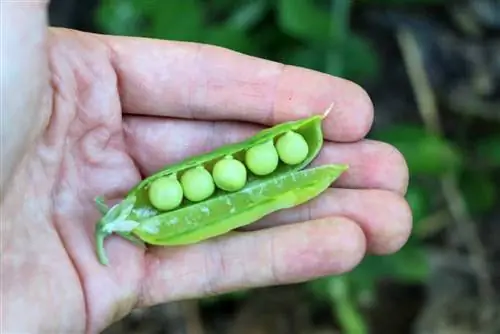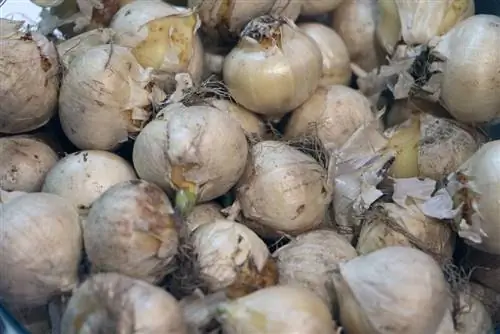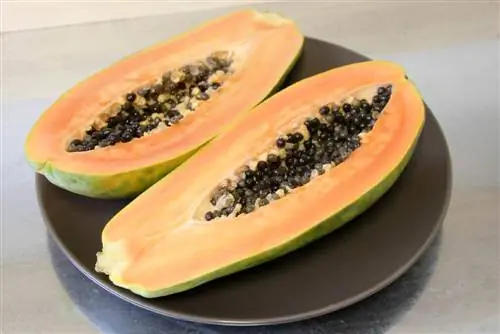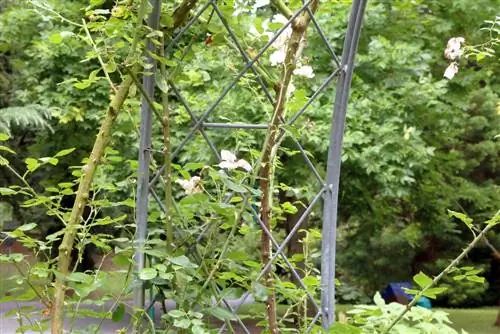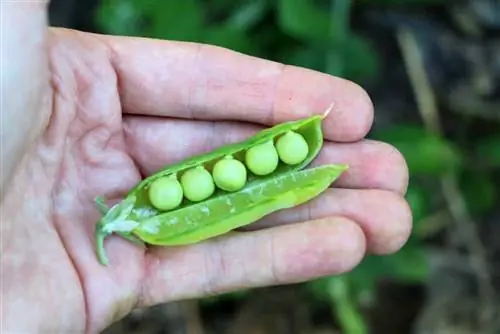- Author admin [email protected].
- Public 2023-12-17 03:39.
- Last modified 2025-06-01 06:48.
Fresh, crunchy and he althy - peas are one of the most popular vegetable plants in our latitudes and enrich every garden kitchen. As a rule, cultivation takes place over a large area in the garden; But growing the delicious pods on the balcony can also be worthwhile. If you create optimal space, choose the variety cleverly and care for the vegetables well, you will be able to enjoy a harvest on the balcony or terrace - which may not be enough for freezing, but is enough for fresh consumption.
Selecting peas
If you want to grow peas on the balcony, you should first choose a suitable variety of green vegetable; Basically, there are three different variants:
- the peas
- the marsh pea
- the sweet pea
The peas are starchy and floury; They are consumed at an early stage and are easy to dry and re-swell. For this reason, the pea is often used as a classic ingredient in stews and soups. However, due to space constraints, it is often not possible to grow enough quantities on the balcony to cook several soup dishes from the harvest. The same applies to marsh peas, which taste slightly sweeter than pale peas and cannot be dried.
Sugar peas are particularly suitable for growing on the balcony because they can be eaten completely. In addition, they are often used as a savory ingredient in various (mostly Asian) dishes and are not “wasted” in large quantities. Last but not least, growing these sweet peas is particularly worthwhile because the fresh produce in the supermarket is very expensive.
Location and soil
No matter which type of pea is grown - the vegetable is overall very adaptable and robust. On the balcony, the chosen location should have the following characteristics:
- as sunny as possible
- even partial shade is still tolerated
- as close to the house wall as possible
The proximity of the vegetable plant to a wall offers several advantages; Since there are usually cramped conditions on the balcony and the hobby gardener has to carefully manage the space available, this location can help to make full use of the free space. The pea plant climbs upwards and doesn't take up much space on the house wall.
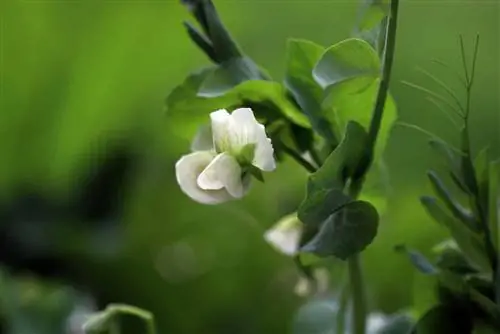
In addition, the wall acts as additional support as the pea plants grow up; Because it can happen that the tendrils slip off their own support structure. Last but not least, the heat is optimally stored on the house wall so that the peas always enjoy sufficiently high temperatures. In addition to the choice of location, the substrate used to plant the peas also plays a role in ensuring a rich harvest. The earth should have certain characteristics:
- pH between 6 and 7, 5
- humos
- rich in lime and potassium s alts
- profound
- not too hard
Vessels and trellises
Peas that are planted on the balcony need suitable containers into which the substrate is filled. If you want to place the vegetables on a house wall, you should choose a particularly long flower box, but it must be very deep. In this way, a long row of peas can be grown along the wall of the house. If you plant the peas in the middle of the balcony, you can also use a pot or bucket; It is important that the planter is of a certain size, as there must later be enough space - around 5cm - between the individual seeds. In addition, a suitable climbing aid is required for cultivating peas on the balcony. To optimally support the plants, the following options are available:
- thin wooden sticks to which young plants are tied
- wire mesh
- small metal grilles
Sowing
Once the container has been filled with soil, sowing can take place. It has proven useful to soak the peas in lukewarm water before sowing. Ideally, the grains should then be left to stand for one night before sowing can begin the following day. Different sowing dates apply to the different pea varieties:
- Pale peas: from mid-March
- Sugar peas: from the end of March
- Peas: beginning of April
- late varieties: in May
Sown in the balcony box, the seeds are placed in the ground in a row. A distance of five centimeters must be maintained between the individual peas. Ideally, the seeds are about 5cm deep in the substrate, and then careful pressing is required. Only one row of peas should be sown in a balcony box; However, various mixed vegetables can be grown before sowing seeds in order to make optimal use of the remaining space in the planter.
Tip:
In particular, a row of lettuce, which is ideally laid out as a seed tape, is a useful addition to the pea seeds.
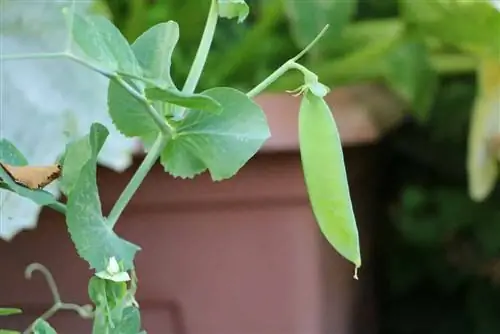
The combination with other compatible vegetables also ensures a lower susceptibility to fungi. It is not advisable to sow another row of peas as there is not enough space in the flower box between the two rows. After sowing, it may make sense to cover the seeds with wide-meshed nets to protect them from being eaten by birds. As the peas grow, the cover must be removed again.
Care
Caring for pea plants includes piling up soil:
- when reaching a height of 10cm
- Soil is piled up around the planting site
- this increases stability
- Soil is also piled over the roots
Caring for the pea family also includes regular watering; However, the individual portions of water must not be too large, as there is a risk of the plant dying if it gets over-wetted. If it rains constantly, the plant should be pulled under the canopy of the balcony.
In addition to optimal watering of the peas, the targeted supply of nutrients also plays a special role in enabling the plants to grow well. Chemical fertilization is not advisable - for both he alth and taste reasons. Alternatively, the following nutrient supply options are available:
- organic liquid fertilizers
- Rock flour
- Nettle broth
Note: Fertilizer in the form of pellets or grains should generally be avoided when growing in balcony containers, as this usually breaks down only slowly. The small amount of substrate could mean that the fertilizer cannot break down and spread optimally - the result is mold.
Caring for the peas also includes loosening the soil, which should be done occasionally. This will prevent any weeds from spreading.
Harvest
The optimal time to harvest the balcony peas depends on the type of vegetable:
- Shell peas are ready to harvest at the end of May
- Shell peas can be harvested either young or mature
- Peas are harvested from June
- Sugar peas are ready to harvest from June and are picked as tender, young pods
In order to determine the optimal time at which the pods can be harvested, the weather should also be taken into account. It is also advisable to examine the peas individually to find out the level of ripeness. If the peas can already be clearly felt in the pods, they are ripe. The grains usually taste particularly tender and sweet.
If, on the other hand, the peas are clearly visible under the pods, the optimal harvest time has usually been exceeded - the pods lose their taste and quality.
Sugar peas in particular can become bitter very quickly. Especially with this pea variant, constant picking is advisable in order to always achieve the optimal degree of ripeness.
Exceeding the level of maturity can be recognized by the following characteristics:
- floury taste
- bitter aftertaste
- particularly hard consistency
- increasing toughness
Tip:
Peas should still be green when harvested; Sugar peas are already ready to harvest when the first seeds appear under the pod.
Most of the time, the harvest that can be expected from the balcony garden is not as plentiful as with outdoor vegetables. If you have picked a large portion of peas and cannot eat them immediately, it is best to store the vegetables in the refrigerator. But even with optimal cooling, the peas can be kept for a maximum of three days. If frozen, the shelf life is extended by several months.
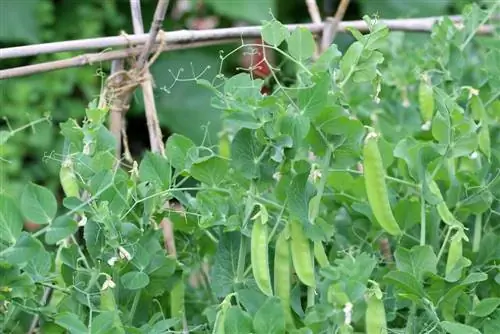
After harvesting, the pea tendrils should be cut off close to the ground. It has proven useful to leave the underground parts in the ground for a while, as the roots enrich the substrate with nitrogen. This natural fertilizer prepares the soil - ideal for subsequent sowing of nutrient-loving vegetables in early summer. In this way, the capacity on the balcony is optimally utilized.
Diseases and pests
A feared disease in the pea plant is powdery mildew, which is shown by the following damage:
- initially white leaf coating
- Covers later turn grey-brown
- Brown color of the pods
- Cripples of entire plants
Be careful on the balcony, especially on warm summer days when the heat builds up; then the fungal disease spreads. Fungicides containing sulfur can provide quick relief. Various care errors can also pose a danger to the pea plants on the balcony - especially if too little substrate is used when cultivating the plants.
Peas are medium-deep rooters and require sufficient soil to thrive - and therefore the deepest possible balcony boxes with a large volume. Otherwise, nutrient deficiencies can quickly occur, which is reflected in the yellowing of the plant parts.
In addition to classic plant diseases, pests can also be dangerous for peas. These include:
- Pea Moth
- Pea beetle
- Pea leaf edge beetle
In general, caution is advised when infested with pests; These should never be treated with a strong fungicide because the peas are intended for consumption and breakdown products from chemical products can accumulate in the vegetable. The use of natural enemies, such as parasitic wasps and ladybirds, is more suitable. Due to the cramped conditions on the balcony, it is important to ensure that the pea plants are not too close to each other and that the minimum distance is always maintained.
Otherwise, diseases and pests can spread quickly and destroy the entire crop. Overall, however, growing peas has also proven successful on the balcony. Anyone who pays attention to the special conditions that come with cultivating this popular and he althy fruit in a small space will have great fun with the crunchy vegetables - and be able to spice up one or two dishes with them!

